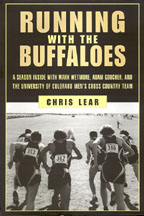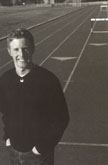|
Web
Exclusives:Features October
10, 2001: By Rich O’Brien Originally self-published, Running With the Buffaloes quickly became, as the Boulder Daily Camera dubbed it, “a cult classic,” thanks to word of mouth — and word of mouse — as running enthusiasts across the Internet emailed friends and teammates with rave reviews and clicked in orders to Amazon.com. Impressed with the book’s grassroots success, Lyons Press bought Running With the Buffaloes late last year and released it in hardback this fall. The first printing, of 5,000 copies, has already sold out. (For more information, visit runwiththebuffs.com.) Lear, a national-class high school miler in New Jersey who went on to become a two-time All-America and cross-country captain at Princeton, still runs seriously on the roads and trails around his home in Boulder. Currently working full-time in business development for zipsend.com, an email gift service, he also writes about running for a variety of magazines and web sites. PAW: Belgium? You’re supposed to be a Jersey boy. CL: My mother was born in Belgium. She met my dad when she came to the States as a young woman. He was from Newark. I grew up, along with my twin brother, Tim ’96 , and my sister, Frederique ’00, in Summit, New Jersey, but we went to Belgium every summer and stayed in my grandparents’ house. I actually went to first and second grade in Gobertange, in a one-room school house. PAW: Did you always want to be a writer? CL: Not at all. I know that a lot of people come to Princeton intending to be a writer. I didn’t. I never even took a writing class. I was a sociology major. But I enjoyed working on my thesis [on the gentrification of Hoboken, New Jersey] , and my adviser, Suzanne Keller, liked it and encouraged me to keep writing. I began to think of it as something I might want to do. PAW: What was the genesis of the book? CL: I’d always been an avid reader of nonfiction sports writing. I loved John McPhee ’53’s book on Bradley ’65 and John Feinstein’s Season on the Brink, about the Indiana basketball program under Bob Knight — which, obviously, was something of a model for Buffaloes — but I hadn’t really found any writing like that on running. Most of the books I’d read were either how-to training guides, or more spiritual in nature. It seemed to me there was room for good non-fiction running reporting. PAW: Did you set out to do the book immediately after graduation? CL: No. After leaving Princeton, I joined Project 55. I spent 10 months in the San Francisco Bay area working as an intern at the Ecumenical Association for Housing, developing a computer-learning center for them. I didn’t know a thing about computers, but I learned on the job. When the internship ended, I got hired as a director, setting up learning centers for low-income housing projects throughout the area. I gave myself a year time-line to get those up and running and then, on July 6, 1998, I moved to Colorado to do the book. PAW: Like Bob Knight, the controversial larger-than-life Indiana coach who dominates A Season on the Brink, Coach Wetmore comes across as a strong, controlling type. Why did you choose his program, and how did he feel about having you around for the season? CL: I had met Coach Wetmore when I was in high school. He had been coach at Bernardsville High and had just taken a job at Seton Hall. I remember being amazed at how much faster his guys at Bernardsville were running. I kept in touch with him even after he went to Colorado — he used to recommend books for me to read, On the Road and others — and when I thought of doing the project, he seemed like the most compelling figure out there. Plus, I knew America loves a winner, and Colorado had its best team ever. Wetmore wasn’t too keen on the idea at first. He felt it was taking a big risk and he was worried about how I was going to treat his runners in the book and also whether I could pull it off. You definitely have to prove yourself to him. I think that when he saw I wasn’t going to be a pain in the ass — but just a fly on the wall — he agreed to it. On one of my first days there, though, I went to his office with a list of 20 questions about each of the guys on the team. I could see him getting tenser and tenser behind his desk, just going completely white-knuckle, until he suddenly yelled, “Lear! It’s not going to be like this all season, is it?” PAW: Some of the book’s best moments take the reader along almost stride-for-stride with Goucher and the other athletes on some truly astounding workouts and races. Were you running along beside them with a notebook? CL: I had originally thought of the book as a kind of Paper Lion approach, in which I would run with the team, but I had just had surgery on my foot and was in a boot-cast. That turned out to be a blessing in disguise. I got a mountain bike and basically reported on the fly. When Goucher was on a 20-mile run, cranking it down to five-minute pace, I could be right there. PAW: Getting the book published was something of a marathon in its own right, wasn’t it? CL: I was a real rube. Before I started, I had pitched it to several publishers, but got no interest at all. One guy actually laughed at me on the phone. Then, after I had the manuscript in hand, I sent it to 10 or 12 houses, but got nowhere. Some said they thought it was a good story, but they didn’t think it would sell. I knew I couldn’t let it die, so I self-published the book and set up a website to promote it. That was right around the time of the 2000 Olympic trials, in which Goucher won the 5,000, and the book got mentioned in some of the coverage. The hard-core running community started to hear about it. Suddenly, I was selling 100-200 copies a day. Last winter, Lyons Press, which had originally turned the manuscript down, came back and said ‘We made a mistake,’ and bought the book. None of it would have been possible without the Internet. PAW: What’s next down the road? CL: I’m trying my hand at business right now, but I’m also continuing to write. I’d love to make a living as a journalist.
|

 Running
With the Buffaloes, by Chris Lear ’96, is a gritty and engaging
behind-the-scenes account of the University of Colorado cross-country
team’s 1998 season. The book, in Band-of-Brothers fashion,
brings alive the struggles, both aerobic and emotional, of a group
of young men training and racing at the very highest level. Dominating
the narrative are Mark Wetmore, Colorado’s charismatic, demanding
— and extraordinarily successful coach — and Adam Goucher,
the Buffalo star who in the fall of ’98 was just coming into
his own as America’s best distance runner.
Running
With the Buffaloes, by Chris Lear ’96, is a gritty and engaging
behind-the-scenes account of the University of Colorado cross-country
team’s 1998 season. The book, in Band-of-Brothers fashion,
brings alive the struggles, both aerobic and emotional, of a group
of young men training and racing at the very highest level. Dominating
the narrative are Mark Wetmore, Colorado’s charismatic, demanding
— and extraordinarily successful coach — and Adam Goucher,
the Buffalo star who in the fall of ’98 was just coming into
his own as America’s best distance runner.
 PAW
Online caught up with Lear by phone during his recent visit to his
family’s old home in the town of Gobertange, Belgium.
PAW
Online caught up with Lear by phone during his recent visit to his
family’s old home in the town of Gobertange, Belgium.